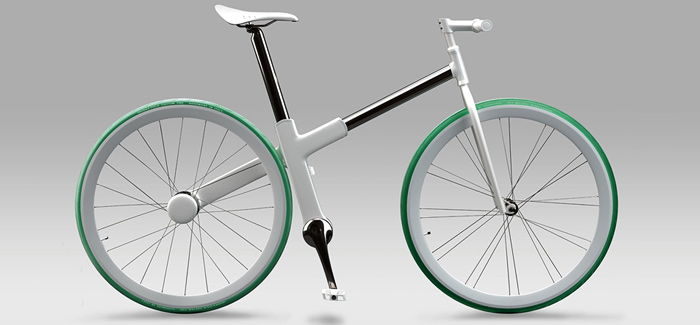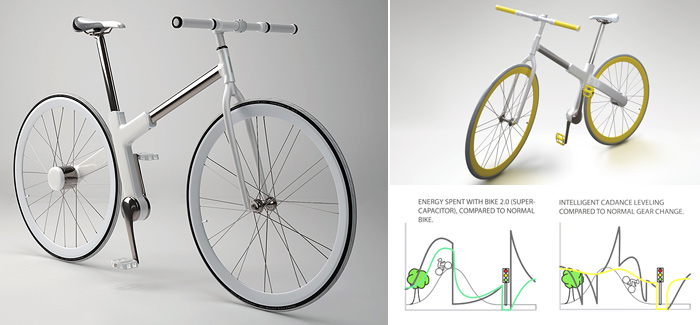
The online design website designboom.com in collaboration with seoul design foundation organized a competition on bicycle design. 3078 entries from 88 countries created a huge variety of imaginative designs but the winner was the amazingly simple ‘Bike 2.0’ from Inoda + Sveje, a studio based in Milan Italy comprised from Kyoko Inoda and Nils Sveje.---
The Bike 2.0 is named after the intention to shift cycling to the next level, by using the technology that is now available and very clever design and packaging. It is targeted towards the cyclist that uses its bike mostly as an everyday tool and not as sports equipment. The most important innovation is the elimination of what is probably the messiest part of the common bike, the chain and transmission mechanism.

Bike 2.0 uses a generator between the pedals and an electric engine in the hub of the rear wheel. The system is electronically controlled and also uses a super-capacitor in the loop. The cyclist spins the generator that powers the rear motor. A continuously variable transmission is mentioned but it will probably have no mechanical parts, it could be just electronic control of the power-flow between the generator the super-capacitor and motor. The supercapacitor exists just to aid the power flow, in the standard configuration the power that the cyclist generates reaches as is the rear motor. The brakes use the electric impedance of the motor. An optional small battery could be added in the seat post to ease the work of the cyclist and also capture some of the energy lost during braking.

The ergonomics are also a very core feature of Bike 2.0. The electric drive and braking eliminates the need for exposed mechanisms. The cyclist has three round controls where the cadence and optionally battery boost and assistance cam be adjusted. Pedaling backwards provides the braking. The bike use standard wheels and tires and the telescopic main beam on the frame can adapt the bike to most people.
There is no working prototype, this is just a design concept but in principal it seems very well thought-out. Similar systems have already been tested and another way to achieve the same result is a hydraulic drive where instead of a generator there is a pump and the motor is hydraulic instead of electric. Power losses in electric or hydraulic systems are comparable or even better to a chain transmission and mass production can reduce significantly the cost per unit.

Even without the battery Bike 2.0 should take advantage of the cyclist effort better than a conventional bike, as you can see in the graph above on the right.
Of course there is a distance between conceptual thinking and a working prototype even more so to a final product. However this is a path worthy of exploration and parts of Bike 2.0 may be useful to a much wider range of bicycle designs, for example the electric drive may be ideal for downhill bikes and the adjustable frame will be very useful in kids bikes.
The results of the Seoul Cycle Design Competition 2010 with the full list of entries (and many interesting concepts) can be found here: http://www.designboom.com/contest/winner.php?contest_pk=33